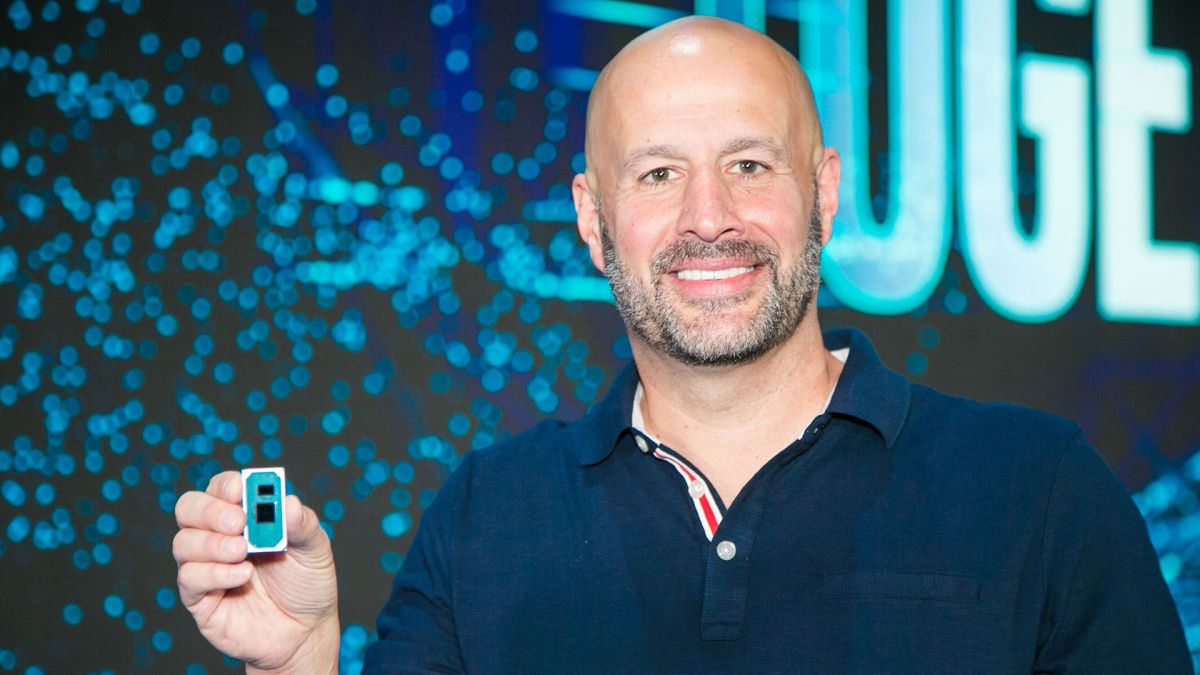Intel finally unveils 10th Gen 10nm Ice Lake processors
⌨️
Intel’s Gregory Bryant holds Ice Lake CPUs at Computex 2019. (Image credit: Intel)
Three years later than originally planned, Intel has finally launched a full line of 10nm processors. Fittingly, these will also be 10th Gen Core processors, and they bring a lot of changes to Intel’s CPU architecture. One thing to note, however, is that these initial Ice Lake parts are only available for mobile products. Maybe that will change in the coming year, but with the arrival of the sixth round of 14nm (probably +++) desktop parts codenamed Comet Lake, there’s a good chance Ice Lake will only be used in laptops. More specifically, Ice Lake is currently only available in 4-core and 2-core variants designed for ultra-thin laptops — which Intel classifies as U- and Y-series parts.
Naturally, 10th Gen CPUs mean new model names, and Intel has also updated its Core i3/i5/i7 branding. Initially, the models looked a little odd as they looked like a step backwards. We’re moving from part names like Core i7-8557U to newer models like Core i7-1065G7. Added an extra number at the end, but visually it looks like it goes from the 8th generation 8000 series CPUs (no 9000 series U or Y series CPUs) to the 10th generation 1000 series. However, once you decode what the part numbers mean, they actually do make more sense. Here’s a full list of the 11 models launched today:
(Image credit: Jared Walton)
Let’s quickly unpack the model. There are six slightly more powerful U-series parts and five Y-series parts. Currently, all Y-series processors have a zero in the fourth digit, while U-series have either a 5 or an 8, the latter being the only 28W model. The first two digits are of course 10, and for 10th gen CPUs the third digit is basically the CPU family – 0 for i3, 3 for i5, 6 for i7 (because using 3/5/7 is too confusing). Finally , the fifth character is a G (presumably graphics), and the last number represents the graphics configuration. The G7 model has a full 64 EU configuration, the G4 has 48 EUs, and the G1 has 32 EUs. The G4 and G7 models also feature Intel Iris Plus Graphics branding.
Clock speed, cache and core count are pretty straightforward. All but the 28W model have a very low base frequency, which makes sense. You may also see a higher base frequency if your U-series chip is in a higher power ConfigUP state. Maximum clock speeds range from 3.2GHz on the Y-series i3 models to 4.1GHz on the 1068G7, and Intel has also disclosed an all-core max frequency of up to 3.6GHz on the 1068G7 from the same 3.2GHz. GPU maximum clocks vary by CPU family: 0.9GHz for Core i3, 1.05GHz for Core i5, and 1.1GHz for Core i7. The same goes for the L3 cache: 8MB for the i7, 6MB for the i5, and 4MB for the i3. Lastly, all i7 and i5 models are 4-core/8-thread CPUs, and the Core i3 parts are 2-core/4-thread chips – I would avoid these i3 parts because I’m long past “enough” on 2-core processors.
Intel hasn’t disclosed any Y-series parts or pricing for the 28W Core i7-1068G7.Of course, none of these prices real Important because you can only buy these as part of a notebook. Even a “suggested” price is basically meaningless, as the amount of RAM and SSD storage, display, and other features all affect the final cost. I’d expect base-model i3 laptops to start at around $700, and Core i5 and up to start at $1,000 or more.
Closeup of Ice Lake Wafer. (Image credit: Intel)
Ice Lake processors all come in a single package where the CPU cores are adjacent to the chipset, similar to previous-generation U- and Y-series parts. New to this generation is integrated support for Thunderbolt 3 and Wi-Fi 6 (formerly 802.11ax) networking. Each CPU is capable of supporting up to four Thunderbolt 3 ports, as well as 2×2 160MHz Wi-Fi streams at a theoretical maximum speed of 2.4Gbps—yes, maybe even faster than wired Gigabit Ethernet.
In addition to the above specs, Intel has used the new Sunny Cove architecture, which includes a lot of updates. AnandTech’s Ian over digs into the full details of the Sunny Cove architecture, but it’s worth noting that this is Intel’s first real architecture refresh in four years. Skylake, Kaby Lake, Coffee Lake, and Coffee Lake refresh all use the same basic architecture. Sunny Cove finally has something new.
A quick summary of the changes is that Sunny Cove is deeper and wider than the Skylake variant. Reservation stations can now send up to 10 instructions per cycle, a 25% increase over Skylake. There are two additional pipes (one AGU and one for storing data), and the L1 data cache bandwidth is effectively doubled. The L1 data cache is also 50% larger (48KB) than before, the first change to the L1 cache since Intel’s first Core i7 part went offline more than a decade ago. Likewise, the size of the L2 cache per core has doubled from 256KB to 512KB. Add some other larger buffers, such as the micro-op cache and reorder buffer, and some improvements in branch prediction accuracy. Finally, Sunny Cove brings AVX-512 support to the consumer CPU lineup for the first time – previously it was only available in Skylake-X CPUs (and the discontinued Cannon Lake).
There’s another notable architectural change, Intel’s new DL Boost and new AVX-512 instructions. Basically, Sunny Cove has some extra instructions to make some complex math calculations more efficient. Intel is pushing the AI side under the DL Boost marketing name (DL = deep learning), but how this will play out in consumer laptops is vague at best. For the data center, DL Boost should improve the training speed of the AI network, while on the client side it should improve the inference speed. But what kind of inferences does the laptop make? This is the unclear part.
New Intel 10th Gen branding (Image credit: Intel)
The real question is what kind of performance can we get out of the Ice Lake and Sunny Cove architectures. For the first round of products, TDP is definitely a factor. In most workloads, all max clock speeds are unlikely to be sustained clock speeds, although 28W parts and cUP 25W laptops should manage higher sustained clocks. The CPU can also do short-term boosts to consume up to about 45W of power before dropping to TDP. Regardless, Intel’s goal is to make better use of the available power this round.
The bigger deal will be graphics. Intel claims its new Gen11 graphics will be faster than any other integrated solution. Yes, this includes AMD’s Vega 10 Graphics (though probably not desktop Vega 11 Graphics).
Intel showed off some performance slides at Computex, with the Ice Lake 15W model featuring a Whiskey Lake (i7-8565U) 15W part, Ice Lake boosted performance by 42% to 108%, depending on the game. Compared to the AMD Vega 10 Graphics in the 25W Ryzen 7 3700U, the performance is much closer – the Ice Lake 25W part was a few percentage points slower in a few tests, 16% faster in the others, with an average lead of about 7% . Gaming selection can certainly be a factor, so once we can get a laptop with these chips, we’ll have to do some independent testing.
What about CPU cores? Intel says Sunny Cove offers an average of 18 percent higher IPC (instructions per clock) compared to Skylake cores. The problem is that clock speed and power are also important factors. In another slide, Intel showed single-thread performance relative to Broadwell U-series processors (the first 14nm parts released in late 2014 and early 2015). Ice Lake is nearly 50% faster than the 15W Broadwell processor in single-threaded performance, but only 3-4% faster than the previous 8th Gen Whiskey Lake processor.
These are Intel numbers, and while we weren’t able to do any testing of Ice Lake ourselves, AnandTech once again got some early performance results. At the same TDP, 10th Gen Ice Lake generally beats 8th Gen Whiskey Lake, but not by much in the CPU test. Gaming performance is another matter, however, with great improvements in the games tested. Basically, Ice Lake has the potential to actually handle 1080p at low to medium quality in many games without the need for a dedicated graphics card. Just don’t expect high frame rates at 1080p in more demanding games like Assassin’s Creed Odyssey.
Finally, Intel’s mass-produced 10nm processors are finally here — or soon. But there’s still something odd about the upcoming Comet Lake CPUs, which will be another 14nm iteration of Skylake’s core architecture. These U-series parts are rumored to offer up to 6-core designs with different naming conventions, but no new architectural updates found in Sunny Cove/Ice Lake. From what I’ve seen, Comet Lake will also hit the desktop long before we see any 10nm desktop parts, and will hit higher clock speeds in the mobile version. Let’s hope Intel’s 7nm transition is a little better than 10nm.
Discover more articles in our categories Gaming & News ou encore Anime.
Thanks for visiting we hope our article Intel finally unveils 10th Gen 10nm Ice Lake processors
, don’t forget to share the article on Facebook, instagram and whatsapp with the hashtags ☑️ #Intel #finally #unveils #10th #Gen #10nm #Ice #Lake #processors ☑️!














Leave a Review